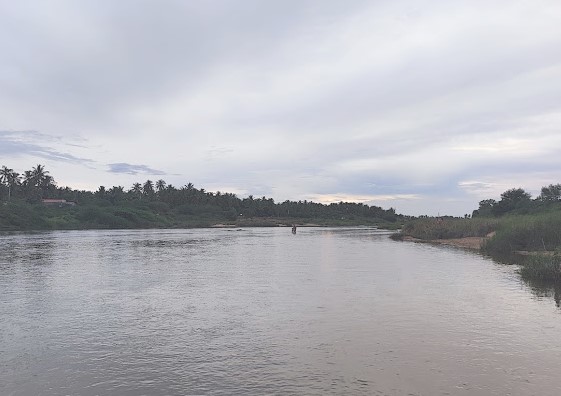This is the 122nd Thevara Paadal Petra Shiva Sthalam and 5th Sthalam on the south side of river Kaveri in Chozha Nadu.
During 6th to 7th Century this place was called as Mookicharam and now called as Uraiyur also spelt as Woraiyur, a part of Tiruchirappalli and a Capital for Chozhas. Pugazh Chozha ruled this place and all the three Kings ( Chera, Chozha & Pandyas ) worshipped Lord Shiva of this temple.
There is a proverb stating that – “Oorenappaduvathu Woraiyur – ஊரெனப்படுவது உறையூர்”. This place is also called as Uranthai.
The Panchavarnaswamy Temple (often spelled Panjavarnaswamy Temple) is a prominent Hindu shrine dedicated to Shiva, located in Woraiyur, a suburb of Tiruchirappalli in Tamil Nadu, India.
Significance:
The temple is named after the presiding deity, Panchavarnaswamy, who is believed to embody five different colours.
It holds a special place in the Thevaram, a 7th-century Tamil Saiva canonical work composed by the revered saint poets known as the Nayanmars. This classification marks it as a Paadal Petra Sthalam, a sacred site praised in these hymns.
Historical Context:
Uraiyur, where the temple is situated, was once the capital of the early Chola dynasty. The ancient city is thought to have been destroyed by a sandstorm.
Notable figures such as Pugazh Chola Nayanar, Kochengata Cholan, and Tirupanazhwar were born here.
The temple, also referred to as Mukkeeswaram, is recognized as the fifth shrine in the series of Thevara Sthalams located south of the Cauvery River.
Several inscriptions from the Chola period can be found within the temple, highlighting its historical significance.
Rituals and Festivals:
The temple conducts six daily rituals from 5:30 a.m. to 8 p.m.
It celebrates three major festivals annually, with the Srivari Brahmotsavam being the most significant, attracting hundreds of thousands of devotees from far and wide.
PURANIC SIGNIFICANCE:
Cock defeating Elephant:
Karikala Cholan, a famous king of Chola dynasty during his travel from Kaviripoompattinam passed through this place. A cock struck the forehead of his elephant. The elephant immediately began to retreat. The king realised the greatness of the place, built a city and stayed here making it his headquarters. The place is also called Uraiyur Kozhi. Kozhi in Tamil means cock.
Tirumukkeswaram:
The place is called Uraiyur or Tirumukkeswaram, was once the capital of Chola kings as noted to Greek traveller Ptolemy. The 7th century Saiva canonical work Thevaram by Tirugnanasambandar mentions the place as "Tirumukeechwaram".
Lord appeared in five different colours to Sage Uthanga:
Panchavarnaswamy, the presiding deity of the temple, derives its name from the word Panchavarnam, meaning five colours. As per Hindu legend, Shiva is believed to have appeared for sage Uthanga in five different colours in five parts of the day (Ratna Lingam in the morning, Spatika Lingam at noon, Gold Lingam in the afternoon, Diamond lingam at night and Chitra lingam later on at midnight).
People worshipped Lord Shiva here:
The temple is believed to have been worshipped by Garuda, Karkodan, Lord Brahmma Lord Vishnu, Sage Kathiru and wife of Sage Kashyapa.
Equivalent to all Shiva Poojas:
Wherever Shiva Puja is performed in any part of this world, all glory of the pujas reaches this place, hence the name Uraiyur bearing this meaning.
Salvation to a Pig:
An atheist ignored the Vibhuti-sacred ash Prasad offered to him in the temple. He was born a pig in his following birth and had to live in ugly muddy environment. He realised that his condition was the result of earlier behaviour. He bathed in the Shiva theertha and was freed from the sin.
Gandhimadhi Amman:
Mother Gandhimadhi Ammai was worshipped by Naga virgins in the Nagaloka – serpent world and was installed here by a Chola king, according to history.
Equivalent to Pancha Boodha Sthalams:
Of the Pancha Bhooda places, Tiruvanaikaval belongs to Water, Kanchipuram to Earth, Tiruvannamalai to Fire, Kalahasthi to Wind-Vayu and Chidambaram to Space-Akasha. The devotee can have the collective benefit of worshipping in these five shrines if he worships Lord Shiva in this temple.
Birthplace of Tirupanazhwar, Kochengatchozha & Pugazh Chola:
Uraiyur also has the reputation of being the birthplace of Vaishnavite saint Tirupanazhwar, Kochengatchozha Nayanar and Saivite saint Pugazh Chola Nayanar. Kochengatchozha Nayanar attained the Lotus Feet of Lord in this place.
Merger of 5 Shiva Lingas to One:
Legend states that a Chola king saw the five daughters of Nagarajan worshipping a Shivalingam each, on the banks of the Naga Theertham. He married the youngest of these princesses and requested his father in law for the Shivalingam that was held in worship by Nagarajan. Nagarajan handed over a half of the Shivalingam to his daughter, who in turn handed it along with the five Shivalingams worshipped by the siblings; these entirely merged into one under a Vilva tree, under which, this temple originated.
Administration:
The temple is maintained and administered by the Hindu Religious and Endowment Board of the Government of Tamil Nadu, ensuring the preservation of its traditions and practices.
7cdde7.jpg)

